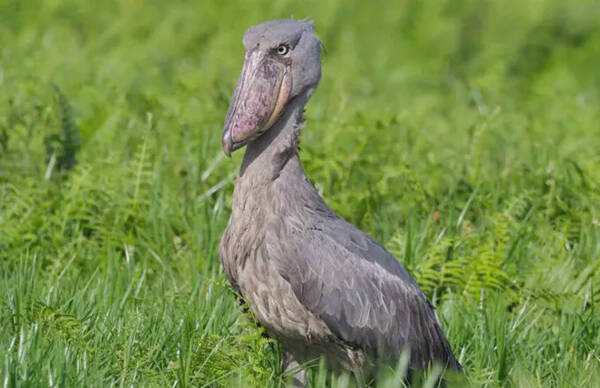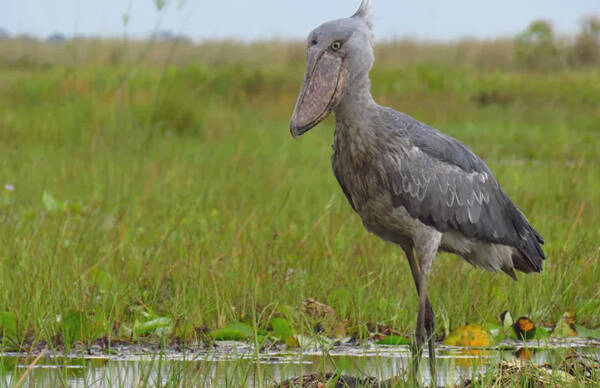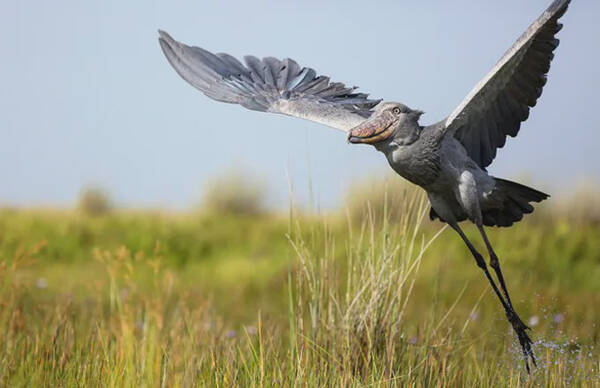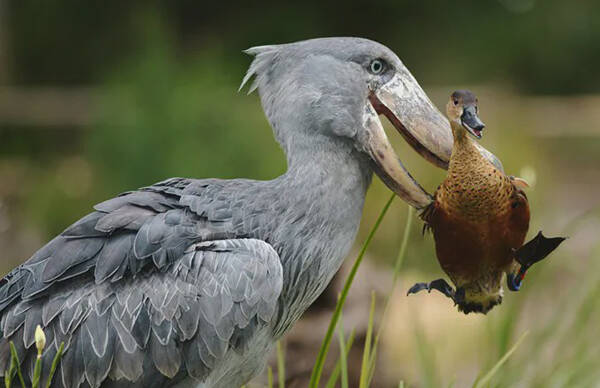Balaeniceps rex
IUCN
LCBasic Information
Scientific classification
- name:Balaeniceps rex
- Scientific Name:Balaeniceps rex,Scorpion Stork, Shoe-billed Stork, Zootropod
- Outline:Waterfowl
- Family:Pelecaniformes S.family Shoebill
Vital signs
- length:1.2-1.5m
- Weight:4-7kg
- lifetime:About 36 years
Feature
The bird with the largest head and widest beak in the world
Distribution and Habitat
The shoebill is distributed in the central interior of Africa, most of which live in Sudan, and are distributed in the Central African Republic, the Democratic Republic of the Congo, Rwanda, South Sudan, Sudan, the United Republic of Tanzania, Uganda, and Zambia.
It mainly inhabits the upper reaches of the Nile River or in the inaccessible lakes and swamps of tropical East Africa.
Appearance
The shoebill is similar in size to the white stork, with a wingspan of up to 2.6 meters. Its feathers are slate gray, with a green sheen on its back, a short tail, and a short crest behind its head. The most striking feature of its appearance is its large head and a thick, large beak like a wooden boot. Although its beak looks heavy, it is actually very light. The male and female have the same color feathers, differing only in size, with the female being slightly smaller. Juveniles are mostly brown, without the green sheen on their backs. Its beak is yellow-green, its iris is white to light yellow, and its feet are black.
Details
The largest bird on earth is the Shoebill, the only species in the genus Shoebill of the family Shoebill. The name of the Shoebill comes from its powerful beak. It is a large bird very similar to the Stork family. It is tall, averaging 1.2 meters tall, weighing 4000-7000 grams, and has a wingspan of 2.6 meters. It is similar in size to the white stork, with a particularly huge head, and is also the largest bird in existence.

The Shoebill has a very interesting and cute face. Its huge, mottled beak makes it even more attractive. The huge beak looks like a whale's head, with the eyes located at the front of the head, on the same plane as the eyes of an owl. The beak is wide and thick, the widest bird beak in the world, 12 cm wide, and the end of the beak is curved downward into a hook shape. The role of the bird's beak is not trivial. Not only is the tip extremely sharp, but the edges are also as sharp as a knife, which can penetrate the thick skin of the crocodile, and the upper and lower pieces clamp the prey so tightly that it is like a workpiece being clamped in a benchworker's vise.
Usually live alone or in pairs, and are completely nocturnal. They hide in the grass or reeds during the day and come out to forage at dusk. Few people find them. However, when people are resting near the floating island, they may see it soaring over the wetlands. When flying, its head and neck are bent into a "Z" shape like a heron or a pelican. It does not sing (the syrinx muscles are degenerated), but it can make a "tick, tick" sound like a white stork. In addition, it can also make a loud noise while gliding.

Mainly feed on fish such as lungfish and catfish, and also catch small crocodiles, turtles, water snakes, snails, frogs and other animals as food, and occasionally prey on lizards, turtles, mice, chickens or young crocodiles. They hide their bodies in the dense water grass at a suitable height by the water, waiting to catch prey. In the dry season, when the swamp dries up, they dig for lungfish that have burrowed into the mud. The clumsy beak of this bird is very suitable for catching fish and frogs, especially lungfish and catfish.

Shoebills usually live alone, with a territory of about 3 square kilometers. Nesting usually begins in the dry season, with a strong sense of territory. Couples work together to defend and destroy the nests of natural enemies or potential competitors. They breed in the rainy season, and lay eggs in the late rainy season, which is from April to June in Uganda. The marriage is monogamous. The male and female birds build nests with branches and reeds in the reeds near the water wetland or on the island. The diameter of the nest is about 1-2 meters, which can be used continuously for several years. The female bird participates in the breeding and feeding of the chicks. The nesting cycle lasts about 6-7 months, and the diameter of the nest is about 1 meter. The eggs are dirty white. The female bird lays 1-3 eggs each time, usually 2 eggs, but often only one chick survives. The male and female take turns to incubate the eggs, and the incubation period is about 30 days. The parents feed the chicks together for about 3 months. After the chicks hatch, the adult birds will use their wings to shade. The chicks will be fully feathered at the end of the dry season, which takes about 60 days. They will leave the nest after 95 days and take off after 105-112 days. It will take 140 days for them to become completely independent. After that, the parents will have to feed them for some time. Sexual maturity is about 3 or 4 years old, and the lifespan is about 36 years.

Currently, BirdLife International and the International Union for Conservation of Nature (IUCN) classify the shoebill as a ‘vulnerable’ (VU) bird. According to IUCN data in 2016, there are still 3,300 to 5,300 adult shoebill storks in the wild, down from 5,000 to 8,000 in 2008. Due to habitat degradation and loss, human activities and illegal bird trade, it is estimated that the number of shoebill storks will continue to decline.
In addition, in the past five years, the local area has introduced many wetland revitalization and wildlife protection measures, which is expected to allow every shoebill to live freely in the swamp wetlands.
Listed in Appendix I, Appendix II and Appendix III of the 2019 edition of the Convention on International Trade in Endangered Species of Wild Fauna and Flora (CITES).
Listed in the IUCN Red List of Threatened Species in 2018 ver 3.1 - Vulnerable (VU).








